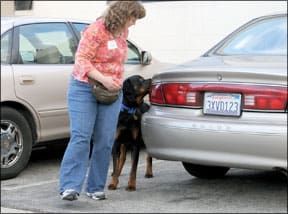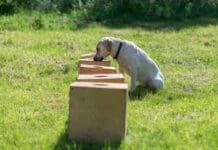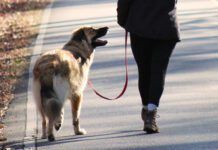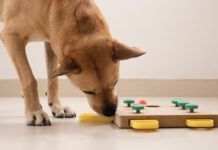[Updated August 17, 2017]
Snapshot: K9 Nose Work
What is this sport? In nose work, dogs indicate the location of a “target” scent by using their natural sense of smell.
Prior training required? None.
Physical demands? On the dog: Mild to moderate. On the handler: Mild to moderate.
Best-suited body structure? No specific structural demands in this sport.
Best-suited temperament? Confident, high-energy, but the sport is also well suited to timid dogs.
Cost? Low.
Training complexity? Low.
Mental stimulation? High.
Physical stimulation value? Moderate.
Recreational opportunities? High; this sport can be played in your backyard.
Competition opportunities and venues? This is a very new sport, primarily available in California, but reaching into other states as instructors become certified.
Although handlers take their dogs to group training classes to learn the game of nose work, only one dog is worked at a time. As a result, this is an ideal sport for dogs who are shy or reactive around people or dogs. It is also ideal for people looking for a sport that is less physically demanding on their dogs and isn’t populated by over-the-top, high-arousal dogs (and handlers).
At the beginning levels of training, dogs are encouraged to “find” their toy in a box. Lavish praise, the toy, and treats reward the dog for his efforts. Later, the toy is hidden in a box among other empty boxes, and the dog is rewarded for finding the box that conceals his toy.
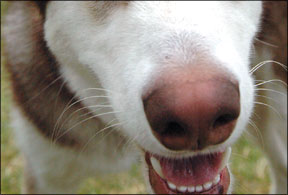
Once the dog gets hooked on the game of “find it,” an essential oil such as birch, anise, or clove is used. A miniscule amount of one of these essential oils is placed on a very small cotton swab. The dog is rewarded for sniffing the container to indicate his find. This essential oil is then placed in more and more difficult locations for the dog to find.
As the dogs learn to play the game, handlers learn how to closely observe their dogs so they know when their dog has found the scent. This “indication” behavior is an important part of the training process since handlers will use their individual dog’s behavior to start rewarding their dog for “indicating” their find. Amy Herot explains why this is important.
“We want the dogs to first learn to enjoy hunting without much handler intervention. Many handlers want to teach their dogs a particular way of ‘indicating’ a successful search – such as barking or a sit – very early in the game. We prefer to take ‘control’ out of the game in the early stages. This frees the dog to just play the game. Later, the handler, from keen observation, can shape the dog to offer a particular behavior that demonstrates he has found the scent. As a trainer, this is one of the most satisfying things about teaching nose work: People learn to pay very close attention to their dogs; they become masters of observation.”
The difficulty of the game increases as the scents are hidden out in the real world in bushes and stairwells and, in vehicle searches, the wheel wells of parked cars and trucks.
There are several levels of competition that are described on the National Association of Canine Scent Work‘s website.
History of Nose Work
The sport of canine scent work is the brainchild of three trainers with experience in training detection dogs for narcotics and explosives. Ron Gaunt was a police dog trainer for 12 years and now runs a private security firm. Amy Herot is a professional trainer and certified detection dog handler and trainer, and Jill-Marie O’Brien is the director of training and behavior for the SPCA LA and is also a certified detection dog handler.
Their collective experience training their own dogs, as well as professional detection dogs, convinced them that companion dogs would benefit from the mental and physical stimulation provided by using their natural sense of smell in a very directed way. (See “The Birth of a Smelly Sport,” below.)
The initial classes quickly filled. Soon, there were long waiting lists, even though additional instructors became certified and other locations added. Co-founder Amy Herot admits that keeping up with demand has been difficult. “One of the biggest challenges for expansion is ensuring the quality of instruction and preventing the dilution of the basic concepts. It’s most important to us that the sport is always fun for the dog (and the human). That said, we are indeed expanding. We have several certified instructors in Southern California, three new instructors in the San Francisco area, one soon to be in New England, one in Denver, and another in Albuquerque. We also look forward to the opportunity of doing workshops to help bring the sport to more locations. Our hope is that more and more dog enthusiasts will become involved and realize the value to their dogs and the relationships they have with their canine companions.”
The Birth of a Smelly Sport
K9 nose work is arguably the newest dog sport to be added to the seemingly endless list of sports created by people who thought, “Hey, my dog loves doing this; I bet other dogs would, too.”
This is exactly what inspired Amy Herot, CPDT, to team up with two of her training partners, Ron Gaunt and Jill-Marie O’Brien, to create fun nose work classes and, later, the sport of canine scent work. The three trainers were convinced that nose work was one of the best ways to mentally and physically stimulate dogs, many of whom have behavior problems because of lack of stimulation.
It started several years ago when Amy became interested in training her own dogs in professional detection work. After a lot of long hours and hard work, Amy’s first dog became certified nationally as a narcotics detection dog. She was hooked. She went on to train and certify several other dogs in both narcotics and explosives detection. She learned a lot from professional detection trainers Ron Gaunt of Travel’n Mandogs (Covina, California), Rodney Spicer of Gold Coast K9 (Oxnard, California), and Andy Jimenez of Falco K9 (Brea, California).
Amy, Ron, and Jill-Marie O’Brien (the director of training and behavior at the SPCALA) started teaching classes in Long Beach, California, trying out the concept of teaching nose work to companion dogs. It took off with a bang. Developing exacting standards for competition came as a natural evolution of teaching those classes.
Amy remembers the early days in 2007:
“The sport idea came later. In the early classes, dogs had been searching for objects (toys, Kongs, food, etc.) We had been playing with the idea of teaching dogs a particular scent in order to advance those classes by making the ‘hides’ smaller and, therefore, more challenging. (It gets difficult to find places to hide a large, stuffed mallard duck without dog and handler seeing it.) We considered some sort of oil, like anise, as that has been used for evaluating detection dogs’ ability to work a novel scent, but we hadn’t settled on anything yet.
“About that same time, I had the opportunity to experiment with the concept while in Seattle during a John Rogerson Instructor’s course. He had invited me to teach the scent discrimination portion of the course and wanted to introduce the concepts of training a dog on odor. All of the dogs in the course were just out of the local shelter and during their three-week stay were exposed to a crash course in tracking, agility, obedience, and nose work. Handlers not only had to get the dogs interested in searching, but also had to train them on an odor and pass an odor-recognition test. John likes to challenge people to be creative in their training and to accomplish a lot in a short time.
“What I witnessed in that course – because of the speed and intensity of training – was a spirited, competitive edge to the nose work that confirmed our thoughts about where we could go with the training in our classes. It proved a good testing ground for using odors with companion dogs and for leveling the playing field in terms of what the dogs were searching for. You can’t really have a competition if one person is hiding a treat bag of hot dogs and the other is hiding a stuffed pink bunny rabbit, but a cotton swab with a dab of oil eliminates that problem.
“When I returned to Los Angeles, Ron, Jill-Marie, and I talked about constructing a class to introduce the dogs to odor, which opened up the possibilities for competition and much
more advanced handling and skill-building for the teams. Those next set of classes helped build the elements we now use in competition for the nose work titles. As handlers got more involved and interested in nose work, we had to keep adding challenges, like exterior area searches and vehicle searches.
“The original purpose of the class, whether dogs are hunting for food or odor, was to have fun. Watching dogs hunt – and watching the light bulb go on for them that they are allowed to hunt – is a beautiful and inspiring experience. I know this to be true every time I witness a dog searching in class. You can hear a pin drop because the observers are watching and listening so intently…often followed by rousing applause when the dog finds it.”
Attributes of a Nose Work Dog
The most attractive thing about this sport is the broad array of dogs that can do it. In essence, if your dog has a nose, he can play this game! Although certified search and rescue and detection dogs have a very demanding job, fun nose work does not place the same physical demands on the dog or handler. Amy Herot describes the difference between fun nose work for companion dogs and police detection work:
“Fun nose work incorporates elements borrowed from skills that we work on with detection dogs without it being detection dog training. Although nose work shares similarities with detection, there is much more that goes into a detection dog.
“Smelling is the easiest thing. The mental and physical ability, stamina, and stability for dogs to endure long and difficult searches are a big part of detection work. The dogs must be highly driven, uninhibited, and focused on their work all the time. The training is technical, requiring dedication, documentation, and certifications. It also presents the handler and/or owner with great liability and pressure.
“Many companion dogs and even sport dogs share the basic sniffing skills of a working dog, but aren’t really suited to live that life. Nose work allows an owner to tap into those skills without pressure and to provide a great outlet for the dog’s natural abilities.

“In our classes, we have Pugs, Whippets, Shepherds, Labs, Shih Tzus, Huskies, Dobermans, Chihuahuas, Beagles, and Jack Russell Terriers, some of which are top nose work competitors. Certainly, the traditional dogs come to mind: German Shepherd Dogs, Bloodhounds, and Labradors. The skills do come naturally to most of them. Other breeds, however, just need the opportunity.”
Scent Work Handler Attributes
This sport requires a human team member who enjoys the simple pleasures of seeing her dog have a good time, without all the equipment and more complex training that is required in many of the other dog sports. The most strenuous part of the sport is running behind or along with your dog as he is working a scent.
Scent Work Equipment and Supplies
Very little is needed to teach your dog to participate in nose work.
• Rewards – Both toys and treats can be used. In the initial stages of training, dogs are encouraged to find a favorite toy or treat bag.
• Target odors – Small bottles of the target odors (essential oils), small cotton swabs, and containers into which the scented swabs are placed are all that is required. These materials can be purchased online from a variety of sources. There is a link at the fun nose work website. Individual supplies are available, as well as a full kit with everything to get started.
Expenses
This is a very inexpensive sport. The costs mentioned below are for participation in a nose work class.
• Essential oils – All materials are provided in the introductory classes. A student who chooses to continue training might want to purchase his/her own materials. A full kit with three essential oils and cotton swabs is $35.
• Classes – A package of six classes runs $95 to $150 depending on the location.
• Entry fees – If you choose to compete, trial fees are only about $30 plus a nominal one-time NACSW membership registration starting in 2010.
Training for Nose Work
Introductory classes focus on building enthusiasm in dogs for finding their toy or treat bag, hidden in an obvious place such as a cardboard box. A lot of praise and generous rewards are used to encourage the dog to continue to use his nose to find the treasure. Continuing classes leverage the dog’s understanding of using his nose to find “target” scents such as anise, birch, and clove. At the beginning, the target scents are in easy-to-find locations; as skills develop, they are hidden in more difficult locations.
People whose dogs are fearful or reactive around other dogs find that fun nose work classes are a rare opportunity to take their dogs to a class. That’s because one dog is worked at a time, which allows each dog to concentrate on the task at hand instead of other often overwhelming environmental factors. Ramona Audette, a professional trainer in Southern California, was so thrilled with her own dog’s experience in fun nose work classes that she went on to become a certified nose work instructor (CNWI).
“I did not realize the impact fun nose work would have on my dog. I was hesitant to enroll him in the class because of his fear issues. Because there would be no other dogs around him and he didn’t have to engage with anyone but me, I thought, ‘This might work!’ There is such a difference in him today after his involvement with the fun nose work class. His confidence has soared. He loves doing it.

“I have since become a Certified Nose Work Instructor and have been able to see the same results with other dogs. I have seen a Corgi and an English Bulldog go from not wanting to leave their owner’s side and be afraid of a box used in the introductory class, to leaving their owners to go put their head in a box to make ‘their find.'”
Levels of Competition
Currently, dogs as young as six months can compete, and there are three levels of competition.
• NW1 – Dogs earn points for each search for the target scent of birch in each of four locations with maximum time limits assigned to each location:
1. Several cardboard boxes in a row (on- leash).
2. A room in the interior of a building (on- or off-leash).
3. A 1,000-sq. ft. exterior area (on-leash).
4. In up to three vehicles (on-leash).
There are a total of 100 points possible; 90 points are required for an NW1 title.
• NW2 – At this level, dogs must show proficiency with searching for either birch or anise, distractions are added, and the locations become larger and more complex. There are a total of 100 points possible; 95 points are required for an NW2 title.
• NW3 – At this level, dogs must show proficiency with searching for birch, anise, and/or clove.
There are multiple distractions at this level, and one of the rooms in the building can be without scent (a decoy so to speak), and the locations become larger and more complex. The vehicle search includes five vehicles. There are a total of 100 points possible; 100 points are required for an NW3 title.
For detailed information, download the rule book from the NACSW website.
Sniffing Out Confidence
Jesse, a Rhodesian Ridgeback-mix, was four years old when Lezle Stein enrolled him in a nose work class in 2007. Stein is a professional dog trainer and also spends countless hours volunteering with rescue organizations, working with dogs to help them overcome fearfulness. Jesse was afraid of men, children, and new places. He also suffered from separation anxiety, scaling six-foot fences and breaking through windows when suffering from a bout of the disorder. Stein hoped to build his confidence by enrolling him in the nose work class.
“I spend a lot of time in the rescue world working with emotionally damaged dogs. Amy Herot explained that nose work can be an excellent ‘rehab’ for nervous or fearful dogs. They develop confidence, overriding their fears by going back to what comes naturally for them – using their noses! And we make sure they always succeed.”
When Stein first enrolled him, Jesse was too terrified to do anything except cling to her side. Especially terrified of men, Jesse would panic if Ron Gaunt, one of the trainers, came within 10 feet.
“I really would never have guessed how much nose work could improve Jesse’s life. When
he first started, he had zero confidence outside of my house. His strategy was a panicked avoidance and running away so nobody could approach him. He would never bite; he would just shake and pull to get away.”
Stein says the training and positive experiences have completely changed Jesse into a more comfortable dog. “He is a different dog today. He visits with all the class members and is willing and wanting to leave my side to find the scent.
“Amy was so careful and caring to help Jesse and me succeed. The process is slow and methodical in building confidence, but always fun and always with a win at the end. He understands the game and enjoys it now. His separation anxiety has also gone away. And he can say ‘hello’ to men now as well.
“It is a joy beyond words to see any dog, of any breed, awaken their nose and use it to the degree they can. It’s mind-blowing how incredible their ability to smell is, and I still think we have a lot more to learn about that. As a rescue person, I will continue to rehab dogs using their noses.”
And the icing on the cake? Jesse went on to compete as part of a team on two separate occasions. One team took home a first-place blue ribbon and another team took third place.
Overcoming Separation Anxiety
Janice Delaney brought home Mattie, a female Australian Shepherd/Cattle Dog-mix, when Mattie was about six months old. Mattie loves people – perhaps too much! She couldn’t seem to bear being without her owner, and began tearing up Janice’s home any time she was left alone. In an attempt to stop Mattie’s destructiveness, identified by her trainer as separation anxiety, Janice enrolled her in obedience and agility classes. lt wasn’t until Janice enrolled then 13-month-old Mattie in fun nose work classes that her behavior at home improved.
“Nose work was a great overall experience,” Janice recalled. “Mattie loved it and just came
into herself. The training was very well done, from beginning basic box drills to being able to compete in trials. Amy Herot and her colleagues were wonderful at understanding Mattie’s [separation anxiety] issues and allowed her to be in the building where she could watch me but not distract the other dogs from searching. The best part of it all is that Mattie no longer suffers from separation anxiety and has a whole new level of confidence.”
Janice went on to advanced levels of training and entered Mattie in trials starting in 2008. Mattie won her NW1 title on June 7, 2009, and her NW2 in August of that year.
Of special pride to Janice is that Mattie is a recipient of the Harry Award, which was established in 2008 in honor of Harry and his relationship with handler Penny Scott-Fox. Harry was entered in the inaugural nose work trial, but died from a rattlesnake bite just days before the trial. The Harry Award is awarded to “the most outstanding rescue dog that demonstrates extraordinary ability and spirit in nose work,” emphasizing the relationship with the handler and the teamwork.
Is This Sport for You?
This is a sport for just about everyone. It is easy on the handler, easy on the dog, inexpensive, and doesn’t require a lot of equipment. You’re hooked as soon as you see your dog’s face when he realizes that he will be rewarded for using his nose. As usual, have fun, train positively, and revel in the relationship with your dog, not the ribbons on the wall.
Terry Long, CPDT, is a writer, agility instructor, and behavior counselor in Long Beach, California.


